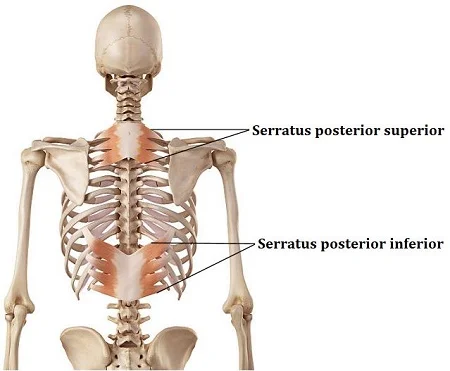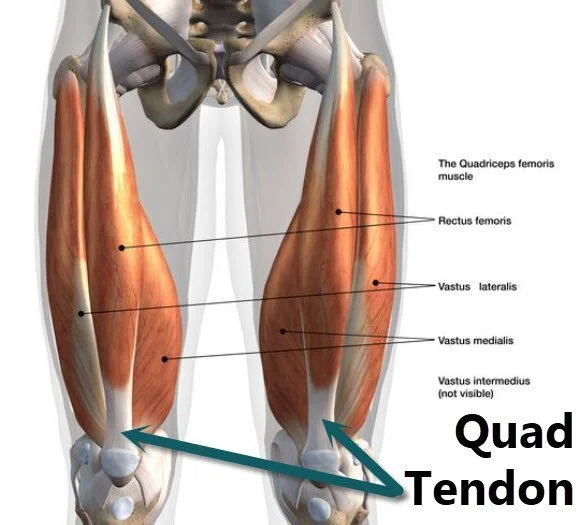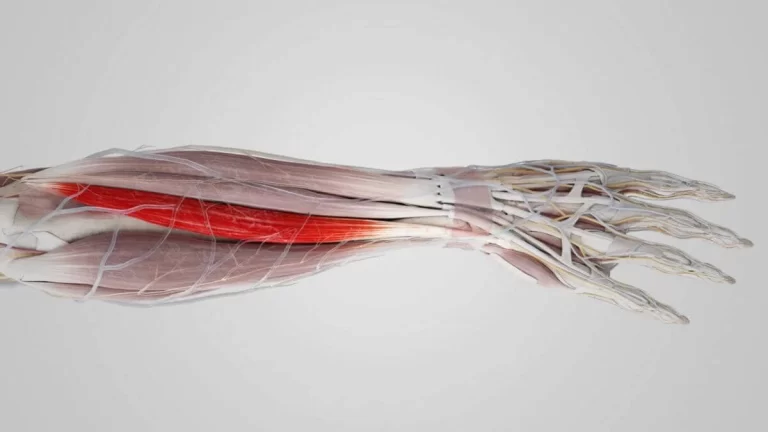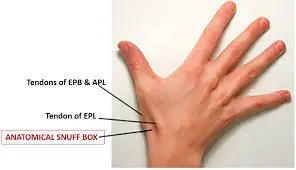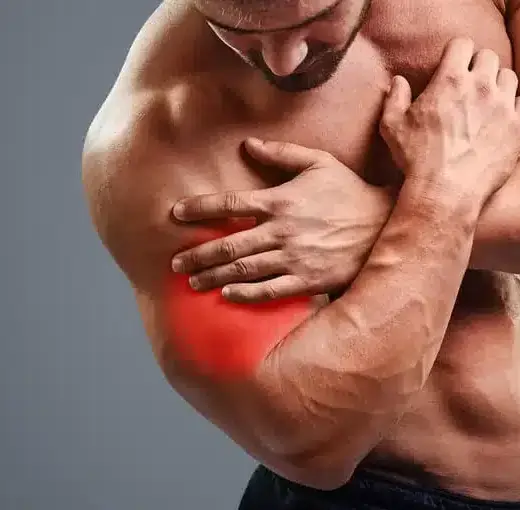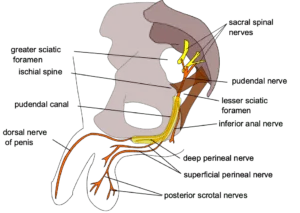Coracohumeral Ligament
Introduction
The coracohumeral ligament is a strong, fibrous band that connects the coracoid process of the scapula to the greater tubercle of the humerus. It plays a key role in stabilizing the shoulder joint, particularly by limiting excessive external rotation and inferior displacement of the humeral head.
By tightening during external rotation and preventing excessive external rotation and inferior translation of the humerus, the coracohumeral ligament strengthens the glenohumeral joint capsule superiorly.
Structure of the Coracohumeral Ligament
The coracohumeral ligament is an important and strong band of connective tissue that connects the scapula’s coracoid process to the humerus’s greater tubercle.
The ligament consists of dense collagen fibers aligned parallel to one another. Tensile forces on these fibers are better tolerated by the stronger ligament. Additionally, the ligament has elastic fibers that enable it to stretch gradually while under pressure, reducing the likelihood of injury and absorbing shock.
Since the superior band is thicker and stronger than the inferior band, it provides most of the ligament’s support.
The shoulder joint receives stability and functionality from the coracohumeral ligament when used with other ligaments and muscles. It aids in avoiding excessive external rotation and humeral abduction, which may cause injury or dislocation. Additionally, it contributes to the distribution of stresses throughout the joint, preventing harm to the surrounding tissues.
All things considered, the coracohumeral ligament is a crucial component of the shoulder joint that helps in function and stability. It is a vital part of a healthy and functional shoulder because of its robust and elastic qualities, which enable it to tolerate the forces put on the joint during movement.
Attachment of the Coracohumeral Ligament
The two different shoulder joint bone components that are attached to the coracohumeral ligament are the scapula’s coracoid process and the humerus’s larger tubercle.
This muscle’s small head begins close to the base of the coracoid process, which is where the coracohumeral ligament’s superior band attaches. This attachment site enables the ligament to support the shoulder joint during flexion and internal rotation of the humerus.
A little groove on the bigger tubercle, called the minor tuberosity, is where the inferior band of the coracohumeral ligament is attached. The ligament can stabilize the shoulder joint during motions including external rotation and humeral abduction because of this attachment point.
The shoulder joint can be supported by the coracohumeral ligament in several of the motion planes thanks to these two attachment points working together. The ligament, which is attached to the scapula and humerus, reduces excessive movement and the risk of joint injury.
Function of the Coracohumeral Ligament
The coracohumeral ligament is an important tissue necessary to keep the shoulder joint stable.
The superior and inferior bands, two separate bands that adhere to various bony landmarks in the shoulder joint, make up the ligament.
The coracohumeral ligament’s main purpose is to keep the shoulder joint stable when moving. This is especially crucial when the humerus is being moved in flexion, extension, internal and external rotation, and abduction. By acting as a restriction, the ligament helps to avoid overuse and possible joint injury.
Internal rotation and flexion of the humerus are supported by the superior band of the coracohumeral ligament, which is attached to the base of the coracoid process. The ligament can withstand severe anterior translation of the humeral head thanks to this attachment point, which would otherwise cause the joint to dislocate or subluxate.
By joining the humerus’s greater tubercle to the smaller tuberosity, the inferior band of the coracohumeral ligament stabilises the humerus during external rotation and abduction. The ligament can withstand severe posterior translation of the humeral head because of its attachment site, which would otherwise cause instability or impingement in the joint.
Apart from offering support during motion, the coracohumeral ligament also contributes to protecting the stability of other shoulder joint components. For example, it supports its long head and prevents the biceps tendon from slipping out of its humeral groove.
It is an essential part of the shoulder’s intricate biomechanics because of its attachment locations on the scapula and humerus, which enable it to offer stability in a variety of planes of motion.
Blood supply of the Coracohumeral Ligament
One of the important ligaments in the shoulder joint is the coracohumeral ligament (CHL). It joins the scapula’s coracoid process to the humerus’s greater tuberosity and is situated in the upper portion of the shoulder.
The surrounding structures are the primary source of vascularization for the coracohumeral ligament in terms of blood supply. These consist of:
One of the main blood sources for the ligament is the suprascapular artery, which serves the muscles and structures surrounding the shoulder.
The coracohumeral ligament can receive blood from the thoracoacromial artery, another essential blood supply to the shoulder region, through its deltoid and acromial branches.
The anterior and posterior circumflex humeral arteries can produce tiny branches that supply the coracohumeral ligament and help in the vascularization of the shoulder joint.
It’s important to remember that, unlike muscles, the coracohumeral ligament lacks a strong, direct blood supply. The blood vessel system around the shoulder, which includes the joint capsule and adjacent muscles like the supraspinatus and subscapularis muscles, provides it with nutrition instead.
Symptoms of the coracohumeral ligament
The degree of the injury may have a bearing on the coracohumeral ligament symptoms. Typical symptoms include the following:
Pain: Pain is the most common sign of an injury to the coracohumeral ligament. Both dull and intense, it is usually felt in the front of the shoulder or upper arm. When the arm is raised or moved, the pain might get worse.
Weakness: An injury to the coracohumeral ligament may result in shoulder and arm weakness. This limitation may make it difficult to elevate or move the arm.
Instability: The shoulder joint is stabilized in large part by the coracohumeral ligament. Injury to the ligaments may induce joint instability, which may lead to dislocation or subluxation.
Range of motion restriction: Shoulder joint range of motion may be restricted due to injuries to the coracohumeral ligament. Daily tasks like lifting objects or reaching overhead may become difficult as a result.
Swelling and bruises: In more severe situations, there may be swelling and bruises around the shoulder joint.
After diagnosing the injury, a medical professional can suggest the best way to take action, which may involve surgery, physical therapy, or rest.
Injuries of the Coracohumeral Ligament
A tiny but crucial ligament in the shoulder joint is the coracohumeral ligament. By connecting the scapula’s coracoid process to the humerus’ larger tubercle, it aids in stabilizing the shoulder joint when in motion. The actions listed below may cause injury to the coracohumeral ligament:
Repetitive overhead motions: Activities like painting, swimming, or throwing a ball that call for repeated overhead motions can cause significant strains on the coracohumeral ligament. This may cause a decrease over time and ultimately lead to an injury.
Trauma: An abrupt injury to the coracohumeral ligament might result from a direct impact to the shoulder or from falling onto an outstretched arm. Contact sports and other activities where there is a high risk of falls are more likely to cause this kind of injury.
Poor posture: The coracohumeral ligament can sustain injuries as a result of poor posture. To increase the risk of injury, slouching or hunching over can put additional strain on the ligament.
Shoulder impingement is a problem that arises when the rotator cuff tendons and other soft tissues of the shoulder are compressed between the shoulder joint’s bones. This increased tension on the coracohumeral ligament may cause injuries.
Aging: Our ligaments and other connective tissues lose their elasticity and become more prone to injuries as we age. This could increase the likelihood of harm and increase the likelihood that the coracohumeral ligament would deteriorate.
Preventing coracohumeral ligament injuries requires taking the right precautions, which include maintaining proper posture, exercising with proper technique, and gradually increasing the duration and intensity of your workouts. To stop further injury and encourage healing, get medical help if you show signs of a coracohumeral ligament injury.
Diagnosis of the coracohumeral ligament
Through a robust band of connective tissue called the coracohumeral ligament, the scapula’s coracoid process is joined to the humerus’s larger tubercle. It inhibits the humeral head’s poor translation and excessive external rotation while stabilizing the shoulder joint.
Finding a coracohumeral ligament injury requires a comprehensive physical examination. You can take the following actions:
Medical history: The doctor will inquire about the patient’s symptoms, such as pain, weakness, and range-of-motion restrictions.
Physical examination: To look for signs of weakness or instability, a doctor will physically examine the shoulder joint. To evaluate the strength of the rotator cuff muscles and other shoulder joint structures, they may use specific tests like the lift-off test or the belly-press test.
Imaging tests: Imaging tests may be needed if the physical examination is insufficient to make a diagnosis. MRIs can give specific images of soft tissues, including ligaments, while X-rays can help rule out other disorders like arthritis or fractures.
Diagnostic injection: In some situations, a diagnostic injection may be used to confirm a diagnosis. After injecting a local anesthetic and steroid medication into the shoulder joint, if the patient gets a significant reduction in pain, this could be a symptom of a coracohumeral ligament injury.
A physical examination, imaging studies, medical history, and diagnostic injections may all be utilized to detect a coracohumeral ligament injury. Depending on how severe the injury was, treatment options could involve surgery, physical therapy, medication, or rest.
Special test
The coracoid impingement test
The coracoid impingement test is a unique examination used to evaluate the coracohumeral ligament’s stability. The humerus bone in the shoulder blade socket is stabilized by this ligament, which is found in the shoulder joint.
The coracoid impingement test involves placing the patient’s arm at their side while they are either standing or sitting. After that, the examiner takes hold of the patient’s elbow and internally rotates their arm, flexing it to 90 degrees. Next, the examiner places their other hand on the coracoid process, a bony protuberance on the front of the shoulder blade.
After applying pressure to the coracoid process, the examiner asks the patient if they feel any pain or discomfort. If the movement creates pain or discomfort in the coracohumeral ligament area, it may indicate a ligament injury.
The coracoid impingement test is frequently used to evaluate shoulder injuries in combination with other specialized testing and physical examination methods. Due to the possibility of other shoulder joint components causing pain or discomfort during this movement, a positive test result might not always suggest a coracohumeral ligament injury.
Treatment of the Coracohumeral Ligament
Conservative treatment
The goal of conservative treatment for a coracohumeral ligament injury is to lessen shoulder joint discomfort and inflammation while improving function. Among the conservative approaches to coracohumeral ligament treatment are the following:
- Rest: Avoid activities that aggravate the shoulder joint since it needs time to recover. To immobilize the shoulder and ease strain on the injured ligament, a sling may be applied.
- Ice therapy: Applying ice to the wound can assist in lessening inflammation, discomfort, and swelling. Throughout the day, apply ice many times for 20 minutes at a time.
- Physical therapy: To increase the range of motion and strengthen the muscles surrounding the shoulder joint, a physical therapist might create an exercise regimen. The range-of-motion, strengthening, and stretching exercises are among them.
- Medication: Over-the-counter nonsteroidal anti-inflammatory drugs (NSAIDs) that help lower pain and inflammation include naproxen and ibuprofen.
- Corticosteroid injections: If conservative treatment doesn’t work, a corticosteroid injection may be recommended. An injection of corticosteroids can decrease inflammation and discomfort in the shoulder joint.
- Platelet-rich plasma (PRP) therapy involves injecting a concentrated mixture of the patient’s blood platelets into the injured area. Growth factors included in platelets may assist in promoting recovery.
Therefore, the basic goal of conservative treatment for a coracohumeral ligament injury is to lessen shoulder joint pain and inflammation while also restoring function. Working with a healthcare professional to create a treatment plan that is suitable for the extent of the injury is crucial.
Physiotherapy treatment
Physiotherapy uses exercises and manual therapy procedures to treat injuries to the coracohumeral ligament. By doing this, shoulder joint function is restored and discomfort and inflammation are lessened. The physiotherapy techniques listed below can be used to treat a coracohumeral ligament injury:
Range-of-motion exercises: These exercises aim to expand the shoulder joint’s range of motion. The shoulder joint can be gently moved through its entire range of motion by the physiotherapist using passive or active-assisted range-of-motion exercises.
Strength training: Strength training is used to build stronger muscles around the shoulder joint. Bodyweight exercises, resistance bands, or weights can be used by the physiotherapist to target particular muscles.
Manual treatment: To lessen shoulder joint pain and inflammation, manual therapy procedures, including massage, joint mobilization, and soft tissue mobilization, may be used. The soft tissues and joints surrounding the shoulder joint may be moved by the physiotherapist using manual techniques.
Correcting posture: Bad posture can lead to shoulder pain and dysfunction. Exercises to strengthen the muscles supporting proper posture may be prescribed by the physiotherapist, who may also offer tips on how to improve posture.
Counseling and education: The physiotherapist may offer guidance on preventing more injuries as well as instruction on how to manage symptoms at home.
In summary, the goals of physiotherapy for a coracohumeral ligament injury are to lessen pain and inflammation, increase shoulder joint strength and range of motion, and restore function. It is essential to collaborate with a qualified physical therapist who can develop a treatment plan tailored to your individual requirements.
Risk Factors of the Coracohumeral Ligament Injury
It keeps the shoulder joint stable and stops it from moving. However, the chance of suffering a coracohumeral ligament injury can be raised by several risk factors. Among them are:
Repetitive overhead motions: Players who engage in repetitive overhead motions, such as baseball pitchers, swimmers, and construction workers, are more likely to get a coracohumeral ligament injury.
Trauma: Dropping anything or hitting the shoulder directly can cause injury to the coracohumeral ligament.
Age: Our connective tissues lose some of their elasticity and become more exposed to injury as we age. A coracohumeral ligament injury may be more likely to occur in older persons.
Poor posture increases the likelihood of coracohumeral rupture and places additional strain on the shoulder joint.
Weakness or imbalance in surrounding muscles: An injury to the coracohumeral ligament is more likely to occur if there is weakness or imbalance in the muscles supporting the shoulder joint.
Prior shoulder injuries: Individuals with a history of shoulder problems, such as a rotator cuff rupture, may be more at risk for coracohumeral ligament injuries.
It is essential to be aware of these risk factors and to take preventative measures against coracohumeral ligament injury. To enhance muscle strength and balance around the shoulder joint, this may involve doing regular strength and conditioning exercises, keeping perfect posture, and warming up and stretching properly before performing physical activity.
How can one prevent a coracohumeral ligament injury?
Following best practices and taking particular precautions are crucial to preventing injury to the coracohumeral ligament. You can avoid suffering a coracohumeral ligament injury by following this advice:
- Stretching and warming up: Before starting any physical exercise, it’s important to stretch and warm up correctly. Injury risk will be decreased as a result of the muscles and joints being ready for the exercise.
- Technique: It’s critical to use suitable methods when playing sports or engaging in other activities that require overhead motions. In addition to lowering the chance of injury, this will lessen the strain on the shoulder joint.
- Muscle-strengthening exercises: Regular strength and conditioning training helps enhance shoulder joint strength and balance. In addition to increasing stability, this will lower the risk of injury.
- The risk of injury and strain on the shoulder joints can be reduced by maintaining proper posture. This involves standing upright, avoiding slouching, and maintaining relaxed shoulders.
- Rest and recovery: It’s essential to get enough rest and recovery to prevent injuries. It’s imperative to avoid overstressing the shoulder joint and to allow the body to recover between exercises.
- Seek medical assistance: It’s critical to get medical help if you suffer from any shoulder joint pain or discomfort. Faster recovery and the avoidance of additional injuries are two benefits of early diagnosis and treatment.
These guidelines can help you keep your shoulder joint healthy and avoid injury to the coracohumeral ligament.
FAQs
What signs and symptoms suggest injury to the coracohumeral ligament?
Shoulder joint pain, weakness, restricted range of motion, and instability can all be signs of a coracohumeral ligament injury.
What are the signs of a coracohumeral ligament injury?
X-rays, MRIs, physical examinations, and occasionally arthroscopies can all be used to identify a coracohumeral ligament injury.
How much time does it take to heal after an injury to the coracohumeral ligament?
The degree of the injury and the course of therapy can affect how long it takes to recover from a coracohumeral ligament injury. While more serious injuries can take months or more to recover, milder ones might just take a few weeks.
Can a coracohumeral ligament injury be prevented?
A coracohumeral ligament injury may not always be avoided, but the risk can be decreased by strengthening the muscles surrounding the shoulder joint, avoiding repetitive overhead movements, and keeping proper posture.
What is the coracohumeral ligament’s primary function?
By preventing the humerus from moving too much, the coracohumeral ligament helps with shoulder joint stability.
How can one treat a coracohumeral ligament injury?
A coracohumeral ligament injury may be use with rest, ice, physical therapy, anti-inflammatory drugs, and, in serious cases, surgery.
References
- Patel, D. (2023c, August 10). Coracohumeral ligament – Anatomy, structure, function, injury. Samarpan Physiotherapy Clinic. https://www.samarpanphysioclinic.com/coracohumeral-ligament/
- Coracohumeral ligament. (2024, April 25). Kenhub. https://www.kenhub.com/en/library/anatomy/coracohumeral-ligament


